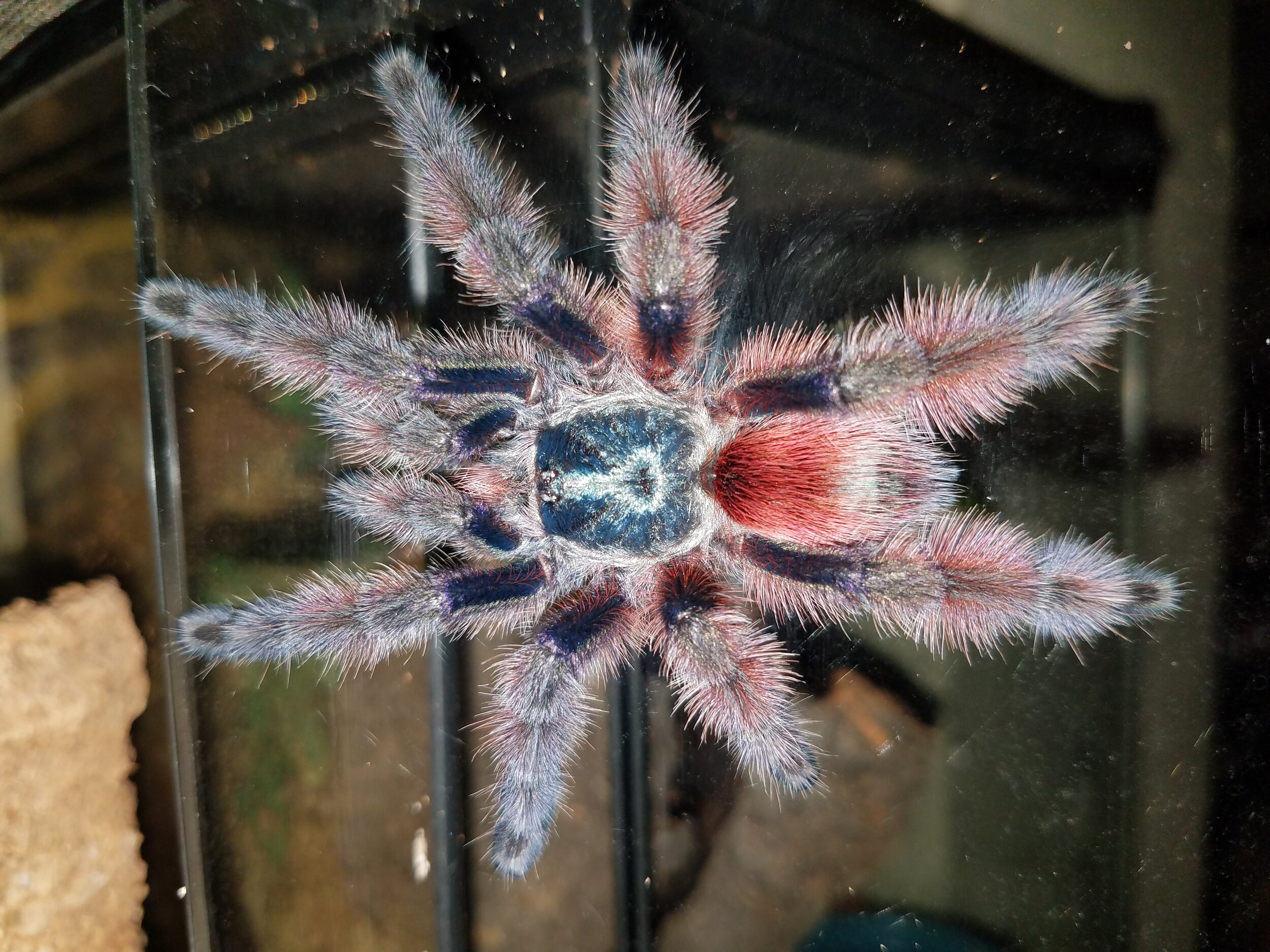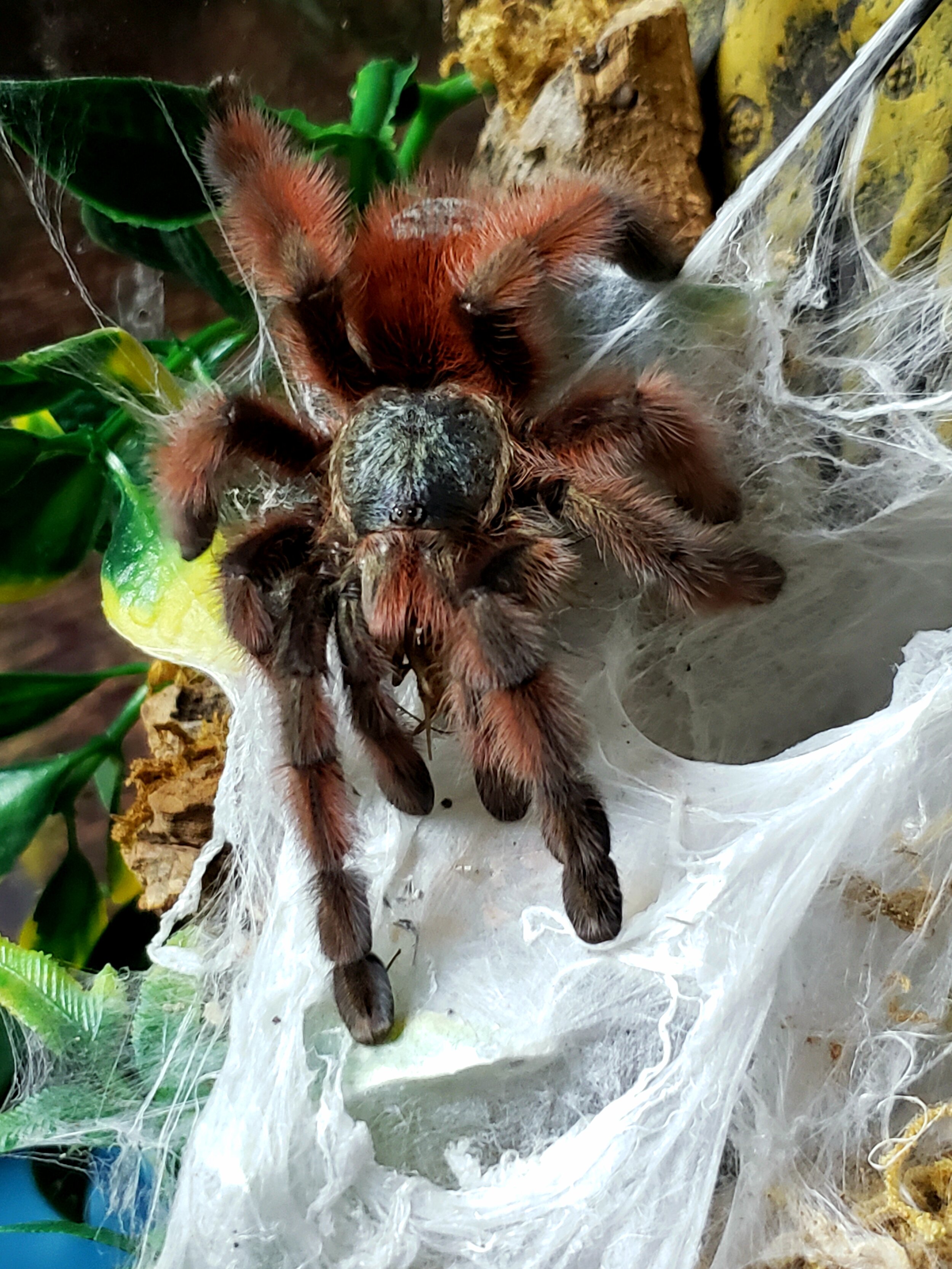Antilles Pintoe Tarantula (Caribena versicolor) Care Sheet

Care & Husbandry Video
This video shows you exactly how I keep and feed my Antilles Pintoe Tarantula. I show you the enclosures I use and the conditions I keep them from a spiderling to an adult tarantula. I also include some additional information on the Caribena versicolor.
Scientific Name: Caribena versicolor
Common Name: Antilles Pinktoe, Martinique Pink toe, Martinique Red Tree Spider
Type: Arboreal
Category: New World
Endemic Location: Caribbean, Martinique, Lesser Antilles
Body Length: 2.5” (6cm)
Diagonal Leg Span (DLS): 6” (15cm)
Urticating Hairs: Yes Type II
Growth Rate: Fast
Life Expectancy: Females 12 years / Males 2-3 years
Recommended Experience Level: Beginner
Caribena versicolor or you may be more familiar with its common name the Martinique or Antilles Pinktoe Tarantula. This species was known for a long time as the Avicularia versicolor but was recently reclassified to the genus Caribena. This is a gorgeous species that starts off as a bright blue spiderling until it molts into its Adult coloration of greens and reds. This is a New World, arboreal tarantula that is endemic to the areas of the Caribbean, Martinique, Lesser Antilles. This is a medium growth tarantula with females living around 12 years and reaching a size of 5 - 6 inches while males live around 2 -3 years and are an inch or 2 smaller. This is a fairly docile species that is known to have mild venom, but can be fast and has a tendency to jump. For many years this species was considered to be difficult to keep and was know to fall to victim to what was called Sudden Avic Death Syndrome, which was a general term used to explain a higher rate of this species randomly dying in captivity. At that time, it was believed that humidity was key to the husbandry of this species based on the environmental conditions of the area this T comes from. So in an attempt to keep the humidity in their enclosures up, ventilation was usually reduced or keepers would mist the inside of the enclosure daily, sometimes 2 or 3 times a day. What was not fully taken into consideration at the time was that these Ts lived in the trees and even though the environment was traditionally a humid one, these Ts made there home in the trees where the coastal winds were prevalent and provided excellent air circulation and they take refuge inside tree trunks, in crevices, or under building or large leaves during downpours. So the key to keeping this species wasn’t so much the humidity you provide as it was making sure this T had excellent ventilation.
I keep my C. versicolors at room temperature, like most of my tarantulas. If you’re comfortable, they’re comfortable. My spiderling versicolors are housed in a large dram vile with appropriately sized holes drilled into the sides of the enclosure with a little moist substrate in the bottom and provide a twig or sliver of cork bark for them to climb and use as anchor points for their webbing. As spiderlings, they tend to make their homes closer to the ground, so i provide them with some sphagnum moss and broken up dried leaves to use to camouflage their webbing. As juveniles, I house them in a basic acrylic arboreal enclosure with more height than width. These are simple clear AMAC boxes that measure 4x4x7.25” and sell for less than $5 a piece, i will provide some links for them down in the description. I drill plenty of ventilation holes on opposite sides of the enclosure just over halfway to ⅔ the way up. This will help provide ample cross ventilation. I intentionally do not drill any ventilation holes on the top of the enclosure to help retain some of the humidity even while providing the cross ventilation. I usually build this type of enclosure for this particular species upside from how the box would normally stand. At this stage of life, this T tends to make web tunnels at the top of the enclosure and if you have to take the lid of the top to fill up the water dish and feed, you will be constantly destroying the versicolors webbing. For adults, you can make a similar style enclosure from larger clear acrylic enclosures if you are into the do-it-yourself aspects of the hobby. There are also plenty of business that make acrylic arboreal enclosures for adults that have ideal cross ventilation. Personally I convert 5 or 10 gallon enclosures into arboreal enclosures and I also use the Exo Terra nano - tall and small tall enclosures with a few modifications. These are glass enclosures with ventilation just under the front door as well as on the top of the enclosure. I usually replace the screen top with a sheet of plexi glass that i cut to fit and drill in some holes for ventilation and glue or silicone in place. That way there is no worry of the T chewing its way through the screen or getting its toes caught. For juveniles and adults, I keep their substrate dry but provide a larger than normal water dish with plenty of surface area and let the natural evaporation of the water provide the humidity the T prefers. Using this type of set has worked well for me for many years and the only deaths I have had were natural and due to old age.
When it comes to feeding I give my spiderlings small crickets or roaches that i pre kill for the smallest slings and drop in live for the larger slings. I don’t feed them any live prey larger than ⅔ the size of the sling. These spiderlings will scavenge, so there is no harm in playing it safe and dropping prekilled prey on their webbing or near the entrance of their burrow. Because i keep the substrate in my slings enclosures a little moist and usually provide them water by dripping it onto their webbing, it is important to remove any uneaten prey or parts within 24 hours of feeding to avoid mold growth and mites. As juveniles I feed 2 medium crickets once a week, more or less depending on their appetite and size of their abdomen. If their abdomen appears swollen but they’re still taking food, I may only feed them one cricket at a time until they refuse food or molt. For adults I feed my versicolors 2 or 3 large crickets every week or two. These are excellent eaters as adults and can surprise you by quickly jumping on their prey as soon as they sense it. I try not to over feed my Ts, but if their abdomen isn’t looking way too big, I may feed them closer to every week or ten days. I also sometimes mix it up a little and feed them a meal worm or dubia, but my versicolors have never shown any interest in wax worms...but that could just be them, though i have fed them a moth that but interestingly love to eat the moths they become, so occasionally i will let a few wax worms grow to maturity as a special treat every now and then, though moths are generally a hassle to deal with and get into the enclosure, so I don’t make a habit of it.
The Caribena versicolor is a stunning tarantula that is always a crowd pleaser. Now usually I avoid handling most of tarantulas, but sometimes the versicolor gives me no choice. As juveniles and adults, this T has occasionally jumped onto my hand while I was feeding or watering and usually will go on a stroll anytime I am rehousing. If this ever happens to you, don’t panic. It is common for them to jump and they probably aren’t going to bite you, and if they do, their venom is very mild and probably poses no health risk unless you randomly happen to have a rare allergy to it. These Ts have Type 2 urticating hairs, which means they don’t kick a cloud of them at you when they feel threatened but transfer of the hairs can come from direct contact. So it it rubs its abdomen on you or you pet it or somehow come in contact with the hairs, be sure to thoroughly wash your hands after handling and be careful not to rub your eyes or touch any parts of your body that may be exceptionally sensitive to the hairs. And as with most Ts, it is highly advised to keep them away from your face as you don’t want to risk urticating hairs getting in your eyes, nose or face.
















